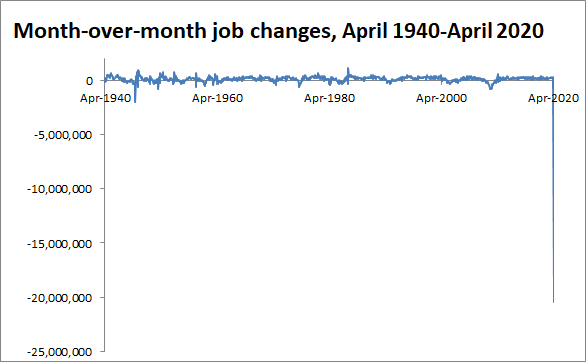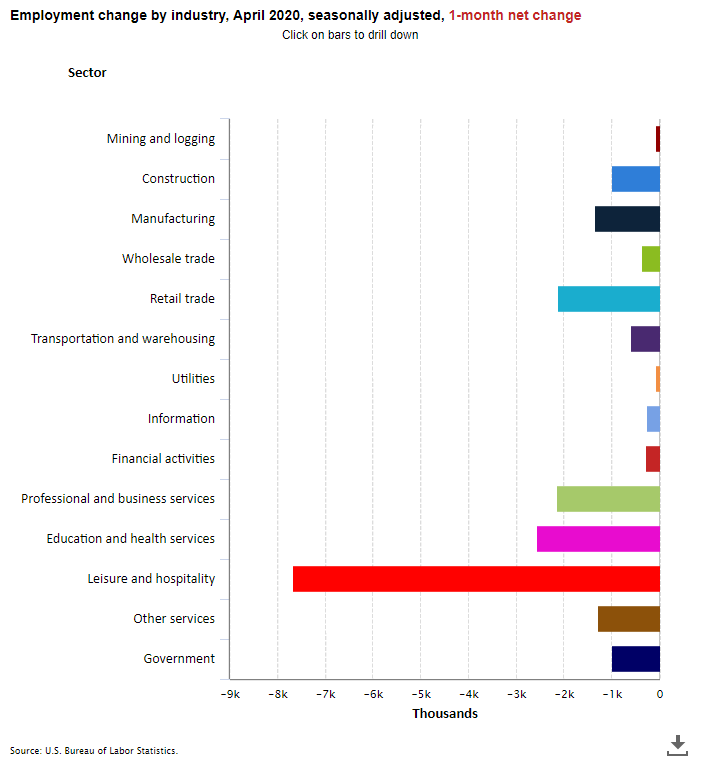BRACE YOURSELF for the most cataclysmic #JobsDay of all of our lives. This chart has monthly job changes over the past 80 years. We lost more than 20 million jobs in April. There has never been anything like this. 1/
Despair is an understandable and reasonable response here. Despair for the millions who’ve lost jobs, for their families, and for the immeasurable amount of lost potential. But then we must demand our policymakers do much, much more. 2/
The official unemployment rate is now 14.7%, up from 3.5% in Feb. But of course, the unemployment rate is not reflecting all coronavirus-related job losses because people are only counted as unemployed if they are actively seeking work, which is currently impossible for many. 3/
Only about two-thirds of coronavirus-related job losses are showing up as unemployed—the rest are showing up as having dropped out of the labor force. If all coronavirus-related job losses had shown up as unemployed, the unemployment rate would now be around 19.0%, not 14.7%. 4/
Further, about 7.5 million workers are likely being misclassified as “employed, not at work” instead of “temporarily unemployed.” If they were classified correctly AND all coronavirus-related job losses had shown up as unemployed, the unemployment rate would be around 23.6%. 5/
Again—if all the workers out of work because of the coronavirus were showing up as unemployed (not out of the labor force or employed but not at work) the unemployment rate would now be 23.6%, not 14.7%. 6/
Some good news: 78.3% of unemployed workers report they are on temporary layoff (i.e. they expect to be called back to their job). I& #39;m concerned some furloughs will turn into layoffs as more businesses go bankrupt, but I am still VERY happy to see that number so high. 7/
This chart shows April changes in employment by industry. Job loss is broad but is hitting low-wage sectors particularly hard (think restaurants, bars, hotels, events, personal services, brick and mortar retail). 8/ https://www.bls.gov/charts/employment-situation/employment-by-industry-monthly-changes.htm">https://www.bls.gov/charts/em...
Wages grew 4.7% in the last month (that’s *73%* at an annual rate). With millions of disproportionately low-wage workers losing their jobs, average wages jumping up like this is NOT GOOD. It’s not because people got big raises, it& #39;s because we dropped low-wage workers. 9/
Many people who have hung on to their jobs are seeing their hours cut. The number of people who are working part-time hours but want full-time jobs increased by over 5 million in April. 10/
The loss of jobs combined with the drop in hours for many of those with jobs means total hours worked has plummeted. Aggregate hours worked in the private sector dropped by 16.2% over the last two months. 11/
How are these jobs numbers different from unemployment insurance claims? Today’s numbers are net changes—not just layoffs where people filed for UI—so they also account for hires, job losses where people didn’t file for UI, quits, and worker deaths. 12/ https://www.epi.org/blog/nearly-one-in-five-workers-applied-for-state-unemployment-insurance-benefits-in-the-last-seven-weeks-congress-must-act-to-mitigate-harm-from-unprecedented-joblessness/">https://www.epi.org/blog/near...
Reminder: because our health care system ties health insurance to work, workers aren’t just losing their jobs, they are also losing their health insurance. 13/ https://www.epi.org/blog/12-7-million-workers-have-likely-lost-employer-provided-health-insurance-since-the-coronavirus-shock-began/">https://www.epi.org/blog/12-7...
CBO projects that without additional relief, the unemployment rate will average 16% in the third quarter of this year and 10.1% for the entire calendar year of 2021. The relief and recovery packages passed so far are not enough, more aid is crucial. 14/ https://www.cbo.gov/publication/56335">https://www.cbo.gov/publicati...
The next package should invest in unemployment insurance, including extending the across-the-board $600 increase in weekly benefits well past its expiration at the end of July—at least until unemployment is falling rapidly and is at a manageable level. 15/ https://www.epi.org/blog/the-extra-600-in-unemployment-insurance-has-been-the-best-response-yet-to-the-economic-shock-of-the-coronavirus-and-should-be-extended/">https://www.epi.org/blog/the-...
The next package should also provide a huge amount of aid to state and local governments, include worker protections, invest in our democracy, and provide relief to the postal service. 16/ https://www.epi.org/blog/the-next-coronavirus-relief-package-should-provide-aid-to-state-and-local-governments-protect-employed-and-unemployed-workers-and-invest-in-our-democracy/">https://www.epi.org/blog/the-...
We also must make large investments in testing and contract tracing because (absent a vaccine or effective treatment) there is no way we can reopen the economy successfully w/o an effective testing and tracing system. We should hire a small army of public workers for this. 17/
Quick must-read #JobsDay summary from @eliselgould https://www.epi.org/press/a-waking-nightmare-todays-jobs-report-shows-20-5-million-jobs-lost-in-april/">https://www.epi.org/press/a-w...
Recessions hit different racial groups differently b/c of things like occupational segregation, discrimination, and other labor market disparities. Right now the official white unemp rate = 14.2%, black unemp rate = 16.7%, latinx unemp rate = 18.9%. 18/
We are also seeing differences by gender, with women facing more job loss. The unemployment rate for women jumped from 3.4% in February to 16.2% in April, while the unemployment rate for men jumped from 3.6% to 13.5%. 19/
More somber news: things have deteriorated substantially since the mid-April reference week today’s numbers are based on—for example at least 6.3 million *more* workers have applied for unemployment insurance. 20/ https://www.epi.org/blog/nearly-one-in-five-workers-applied-for-state-unemployment-insurance-benefits-in-the-last-seven-weeks-congress-must-act-to-mitigate-harm-from-unprecedented-joblessness/">https://www.epi.org/blog/near...
I was struck today that the black & latinx unemp rates (while horrific at 16.7% &18.9%) didn& #39;t rise more, given historic relationships to the white unemp rate. Perhaps an undercount, related to response rates? The CPS response rate was 13 percentage points lower than usual. 21/
One thing I hadn’t noticed in the madness this morning? We already lost almost a million state and local jobs (and note, that is just the beginning). Nearly 500,000 of the losses were in local government education—that’s K-12. FOR THE LOVE OF GOD WE NEED STATE AND LOCAL AID. 22/

 Read on Twitter
Read on Twitter



